
We are developing and demonstrating
new algorithms for the illumination, atmospheric
and temperature invariant recognition of materials in hyperspectral
images. The algorithms are based on the use of invariant representations
computed
from image regions. These invariant representations are derived from
physical models
for image formation and are independent of viewpoint and the illumination,
atmospheric, and thermal environments.
We have shown that invariants can be computed that
capture arbitrary combinations of spectral and spatial information allowing
spectral/spatial tradeoffs to be optimized according to the
characteristics of a particular recognition problem.
Since the algorithms are
derived from physical models,
constraints on the physical
environment can be incorporated to improve performance. Since
invariants can be computed efficiently from hyperspectral imagery without
requiring any form of segmentation, an end-to-end recognition
system has been constructed
based on invariant computation and indexing. Extensive experiments are being
conducted that demonstrate the effectiveness of the approach.
Images
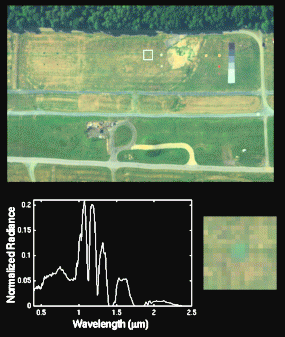
Scene 1: HYDICE (210 bands, 0.4µm-2.5µm) image taken at
Aberdeen Proving Grounds 24 August 1995. Pixels are approximately 1 m².
A zoom of a sunlit green fabric panel is shown in the lower right. The
HYDICE spectral radiance for the panel is shown in the lower left.
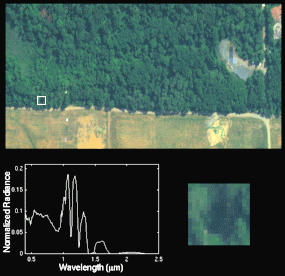
Scene 2: HYDICE (210 bands, 0.4µm-2.5µm) image taken at
Aberdeen Proving Grounds 26 August 1995. Pixels are approximately 1 m².
A zoom of a concealed green fabric panel is shown in the lower right.
This is the same panel shown in Scene 1.
The HYDICE spectral radiance for the panel is shown in the lower left.
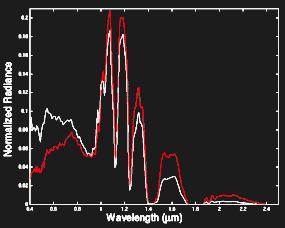
A comparison of the normalized HYDICE spectra for the same green
fabric panel in the two scenes. The red curve corresponds to
Scene 1 and the white curve corresponds to Scene 2.
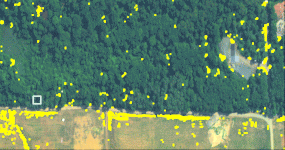
Recognition results obtained when directly comparing the
normalized spectrum for the green fabric from Scene 1 against Scene 2.
Many false matches (shown in yellow) are obtained without matching the
green fabric panel target (inside white box). This demonstrates the need
for the invariant approach developed in [5].
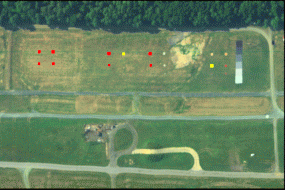
Recognition results obtained using invariant algorithm on
Sunlit panels scene. All eight green material panels are correctly
identified (red pixels) with few false matches (yellow pixels).
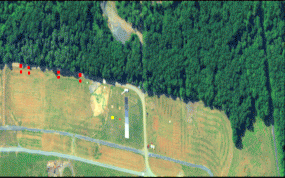
Recognition results obtained using invariant algorithm on
Shaded panels scene. Six of six green fabric panels are correctly
identified (red pixels) with few false matches (yellow pixels).
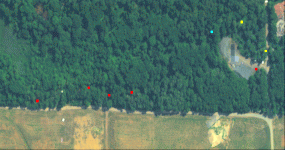
Recognition results obtained using invariant algorithm on
Concealed panels scene. Five of six target green panels are correctly
identified (red pixels, missed panel in blue) with few false matches
(yellow pixels).
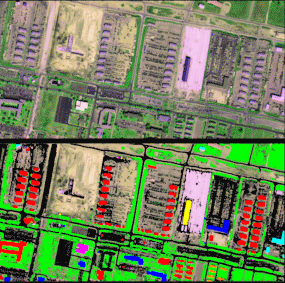
Recognition results for buildings, roads, and vegetation
obtained using invariant algorithm on Fort Hood scene. Results are in
strong agreement with material locations. This data was supplied by the
Digital Mapping Laboratory, Carnegie-Mellon University.
Selected References
- [1] G. Healey
- ``Image Understanding Research at UC Irvine: Automatic Recognition
in Multispectral Imagery,'' Proceedings of the Image
Understanding Workshop, May 1997, 1063-1067.
- [2] D. Slater and G. Healey
- ``ATR in Multispectral Imagery using Physics-based Invariant
Representations,'' ATRWG System and Technology Symposium, Redstone
Arsenal, AL, October, 1997.
- [3] D. Slater and G. Healey
- ``A Method for Material Classification in AVIRIS Data with Unknown
Atmospheric and Geometric Parameters,'' JPL Airborne Earth Science
Workshop, January 1998.
- [4] D. Slater and G. Healey
- ``Exploiting an Atmospheric Model for Automated Invariant Material
Classification in Hyperspectral Imagery,'' SPIE Conference on
Algorithms for Multispectral and Hyperspectral Imagery IV, Orlando,
April 1998.
- [5] G. Healey and L. Benites
- ``Linear Models for Spectral Reflectance Functions over the Mid-Wave
and Long-Wave Infrared,'' Journal of the Optical Society of
America A, 15(8), 2216-2227, August 1998.
- [6] D. Slater and G. Healey
- ``Analyzing the Spectral Dimensionality of Outdoor Visible and
Near-infrared Illumination Functions,'' Journal of the
Optical Society of America A, 15(11), 2913-2920, November 1998.
- [7] G. Healey and D. Slater
- ``Image Understanding Research at UC Irvine: Automated Invariant
Recognition in Hyperspectral Imagery,'' Proceedings of the
DARPA Image Understanding Workshop, 631-639, 1998.
- [8] B. Thai and G. Healey
- ``Invariant Subpixel Material Identification in Hyperspectral
Imagery,''Proceedings of the DARPA Image Understanding
Workshop, 809-814, 1998.
- [9] D. Slater and G. Healey
- ``Reflectance Estimation and Material Identification for 3D
Objects in Outdoor Hyperspectral Images,''Proceedings of
the DARPA Image Understanding Workshop, 815-820, 1998.
- [10] B. Thai, G. Healey, and D. Slater
- `` Invariant Subpixel Material Identification In AVIRIS Imagery,''
JPL AVIRIS Workshop, February 1999.
- [11] B. Thai and G. Healey
- ``Invariant ATR for Subpixel Targets in Hyperspectral Imagery,''
ATRWG System and Technology Symposium, Monterey, March, 1999.
- [12] D. Slater and G. Healey
- ``Material Mapping for 3D Objects in Hyperspectral Images,'' SPIE
International Symposium on Aerospace/Defense Sensing Simulation and
Controls, Orlando, April 1999.
- [13] B. Thai and G. Healey
- ``Invariant Subpixel Target Identification in Hyperspectral Imagery,''
SPIE International Symposium on Aerospace/Defense Sensing Simulation
and Controls, Orlando, April 1999.
- [14] G. Healey and D. Slater
- ``Invariant Recognition in Hyperspectral Images,''
Proceedings of IEEE Conference on Computer Vision and Pattern
Recognition, Vol. I, 438-443, June 1999.
- [15] D. Slater and G. Healey
- ``A Spectral Change Space Representation for Invariant Material
Tracking in Hyperspectral Images,'' SPIE
International Symposium on Optical Science, Engineering, and
Instrumentation (SPIE Annual Meeting), Denver, 18-23 July 1999.
- [16] P. Suen and G. Healey
- ``Modeling and Recognizing Hyperspectral Textures Under Unknown
Conditions,'' SPIE
International Symposium on Optical Science, Engineering, and
Instrumentation (SPIE Annual Meeting), Denver, 18-23 July 1999.
- [17] G. Healey and D. Slater
- ``Models and Methods for Automated Material Identification in
Hyperspectral Imagery Acquired Under Unknown Illumination
and Atmospheric Conditions,'' IEEE Transactions on
Geoscience and Remote Sensing, 37(6) 2706-2717,
November 1999.
- [18] P. Suen, G. Healey and D. Slater
- ``Material Identification over Variation of Scene Conditions and
Viewing Geometry,'' SPIE Volume 4049,
Algorithms for Multispectral, Hyperspectral, and Ultraspectral
Imagery VI, Orlando, Florida, April 2000.
- [19] Z. Pan, G. Healey and D. Slater
- ``Modeling the Spectral Variability of Ground Irradiance Functions,''
SPIE Volume 4049, Algorithms for Multispectral, Hyperspectral,
and Ultraspectral Imagery VI, Orlando, Florida, April 2000.
 Back to the ICVL homepage
Back to the ICVL homepage
Last modified: 06 Nov. 2022









